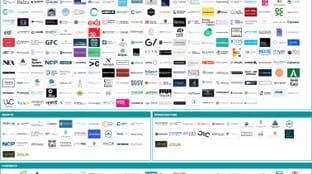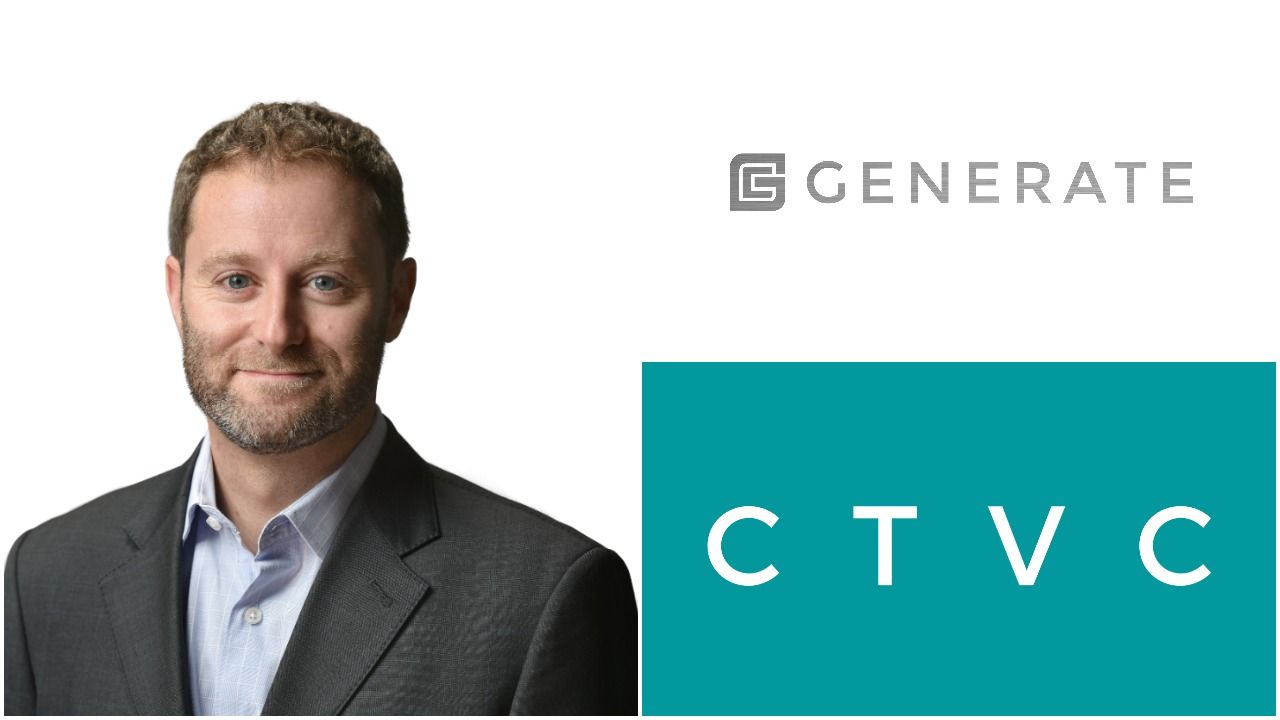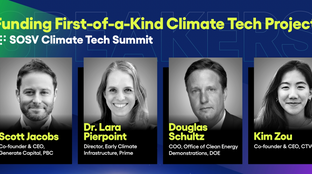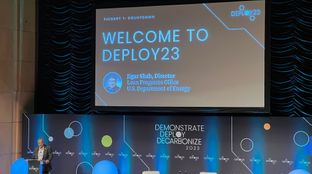
🌏 Who are the Climate Tech Investors?
A new interactive Climate Capital Stack Map
Generate Capital’s Scott Jacobs on deploying innovation

Venture capital is some of the most expensive money out there for founders. For hardware climate businesses, financing projects - especially risky early projects - can land companies in the Valley of Death and keep innovations from reaching deployment. In this conversation, Scott Jacobs, CEO & Co-founder of Generate Capital, compellingly proposes a deeper partnership between VCs and project financiers teaming up on innovation and deployment to bring more climate technologies to scale. Scott and the sustainable infrastructure investment firm that he founded with Jigar Shah (read our September 2020 CTVC feature) and Matan Friedman have been on a tear, and are now one of the largest owners of hydrogen vehicles, community solar and anaerobic digesters in the US. Some might call Generate “The Climate Tech Project Financier”… has a certain ring to it!
When it comes to sustainable infrastructure, you’ve seen it all - as an operator, venture investor, management consultant, and now project finance investor. What insight did you come to on your career journey that led you to start Generate Capital?
My career path might look meandering, starting in technology and then moving into venture capital and energy, but it was always clear to me I needed to do something meaningful. When I first decided I would leave the software world and move into energy and climate, I was really motivated by some of the geopolitical elements of the energy system and how we seemed to fight wars over resources. So I went back to business school, and actually there met Jigar [Shah] while I was working with a VC firm. I was initially thinking that we could reinvent the energy system and solve the geopolitical and environmental challenges through innovation, but our conversations spurred a fundamental insight that climate action wasn’t hindered by an invention problem - it was an infrastructure problem.
Venture is deploying small amounts of money into small teams, who in short periods of time grow big revenues with big margins and produce big exits. In energy, food, water, and transportation that formula doesn’t apply - it’s about big capital, big companies, big governments, who work with long time scales and small margins. So, I started to question the fit of VC in cleantech, and I went to McKinsey in 2007 to start the cleantech practice. Where better than McKinsey to influence big capital, big companies and big governments? Two years later, my group had 2,000 consultants around the globe and access to board rooms, government buildings, and offices, because we reframed the topic of climate solutions - or the ‘resource revolution’, as we called it - as economically-driven decisions. For companies, it was about top line or bottom line growth. For government leaders, it was about national security or economic competitiveness. But we soon discovered the capital markets were completely broken when it came to sustainability. The largest sovereign wealth and pension funds were intrigued by investing in sustainable infrastructure with good cash flows, but Wall Street and asset manager intermediaries stood in the way. In the real economy, like Main Street, you have small scale developers sourcing good projects with good cash flows, and among real asset holders – the sovereign wealth funds, pension funds and insurance companies that actually have the cash – you have investors who really want those attractive long term cash flows. But the real economy and the real asset holders were intermediated by too many parties with short term incentives. So my big asset holder clients kept asking me, “Where’s the vehicle, how can we do this?” At that point, I brought two old friends together to meet each other first, Jigar and Matan, and then the three of us started thinking about how to address this problem at the scale it required rather than with our existing small funds. That question of addressing the problems at scale produced Generate Capital.
There’s a lot of confusion around this asset class. How do you define project finance? And how does it fit into the landscape of sustainable investing?
It’s important to clarify that venture capital is typically capital invested into (early stage) companies that need growth capital to develop a product, test product-market fit, and begin achieving commercial proof and scale. In the sustainability markets, most of these newly developed solutions need infrastructure projects in order for the solution to be implemented. Most customers don’t buy directly from the technology provider - there’s usually a utility or project developer in between because it takes a project developer to build a solar farm. The customer for new solar technologies is actually a project developer.
Project developers are like real estate developers in many ways - they identify a site, find a revenue stream, and organize all of the project elements. Project finance is the art of funding those assets. Technology companies themselves usually do not fund implementation because they have a 30%, up to 200%, cost of capital from high-risk corporate equity investors. Conversely, infrastructure projects are typically low-risk with low-ish returns. So, venture-backed companies with high cost financing can’t afford to use their precious capital to build projects. It’s a different set of capital providers who fund projects, and it is typically the project developer who sources that financing.
Oftentimes, folks confuse project finance as exclusively debt capital - but projects have an entire capital stack that includes both equity and debt. In fact, a project itself is a company! It usually is its own LLC. ‘Project finance’ typically means non-recourse, non-dilutive capital for project building. Non-recourse means that we’re not holding the tech provider or the project developer responsible at the corporate level for anything at the project level. Non-dilutive simply means that we’re funding the projects - not companies - that are developing the projects, which allows for isolation of the project risks and also reduces the cost of capital, because the developer or technology company doesn’t have to issue its own precious equity in order to get the project financed. Founders keep their stock, and so do their VCs, and yet revenue and profit arrive through the project development and financings.
Typically, project finance has senior debt plus project or “sponsor equity.” Sometimes, there’s tax equity or mezzanine financing involved. Just like any other company, project finance is a capital stack, but it’s walled off from any risks that may be outside of the project itself (like the risks VCs take – product-market fit, team building, SG&A spend, etc.).
What’re common misconceptions about climate tech project finance? What do most people get wrong?
Everybody always wants the cheapest financing possible. And no project gets financed without there being an experienced, credible operator ensuring the project actually works as planned. Cost of capital is correlated to the risks involved in an opportunity. With climate tech - or the ‘resource revolution’ as we would call it - the new tech solutions being built into these projects are less proven than traditional projects like a natural gas peaker plant with GE turbines. Fewer operators have ever operated these technologies, so naturally, more risk is perceived in the credibility of a (new) operator. So as capital providers perceive higher risk with these newer solutions, there’s a mismatch between the project developers’ need for customer affordability (from cheap supply costs, including financing, and confident operations) and the cost of capital available to finance novel technologies that haven’t been proven 1000x over 100 years.
Folks often get the notion wrong that project capital should be as cheap as possible. Entrepreneurs often build their financial models assuming that they’re going to get 2-3% traditionally priced debt financing for a project. But 3% debt financing doesn’t work for projects without any equity below the debt taking on some of the risk inherent in any project. A project is not a bond, it’s a company with customers and supply chains and some level of genuine uncertainty (i.e., risk). Then, the question becomes: who’s going to provide the equity, who’s going to take that risk? The tech company with 50% cost of capital from their precious, small venture pool of funding? Or some third-party capital provider who wants to own projects, like a utility or a firm like Generate? Equity capital is critical for accessing the debt financing necessary to complete the capital stack and actually build the project.
How is Generate Capital different from a typical private equity or project finance firm that invests in traditional renewables assets? Why is your approach the first of its kind?
Most project financiers don’t take risks. Generate is willing to take risks that others won’t and, importantly, do the work that others won’t, to actually understand the real risk and value profile of the technologies. Most significantly, we’re willing to actually operate the project for its entire life.
Successful infrastructure projects require a long time horizon that very few actors in the economy can provide. When you say to Walmart “I’m going to provide you with power,” you’re competing with an incumbent government regulated utility that Walmart can comfortably depend on for multiple generations. Can they rely on a Silicon Valley tech company to still be there? Can they rely on a bank or fund manager with rapid capital turnover? Probably not. Walmart needs an actual project operator with the appropriate time horizon, skill set, and dedication to customer success. That’s what’s really novel about Generate - we’re willing to do the work that no one else is even designed to do.
Traditional project financiers also need big projects. Most project investors don’t get out of bed for less than $300m deal sizes. That makes sense for conventional infrastructure like a coal plant or transmission line which comes in bite sizes of hundreds of millions or billions of dollars. It doesn’t work for distributed technologies that are now the best at delivering the most compelling, affordable, and reliable resources to customers. Compared to half a billion dollars, many of the projects Generate looks at are half a million dollars. We’re set up to build, own, operate, and finance those smaller-scale assets which traditional financiers are incapable of financing or operating. It’s a simple math problem. Low-risk projects deliver low returns, which means low revenues. But these investors have expensive bankers, lawyers, investment professionals, and accountants - in other words, high transaction costs. Low revenue, high cost sounds like a low margin business which needs to do a lot of volume to make money. For smaller-scale assets, we’ve reduced those transaction costs in order to deliver a compelling economic proposition to our customers. We built the whole business for small projects, because we know that’s where infrastructure is going, because we know that’s what the customer wants or needs.
How does the “infrastructure-as-a-service” financing model work?
Infrastructure-as-a-service (“IaaS”) is the notion of taking a technology product and delivering a utility service with it. Think of Salesforce’s SaaS approach to transitioning large, multimillion dollar enterprise software licenses into low, monthly bills for customers. Or SunEdison, SunRun, and SolarCity’s solar-as-a-service approach where project developers intercept the technology and customer by buying the technology, building the project, and offering the customer a monthly bill to pay as they go. We recognized that a key barrier to climate tech adoption was the requirement that customers have to (1) buy the technology with their precious budget via a large upfront check and (2) operate the technology over time. IaaS converts large upfront costs with high operational risks into zero upfront cost with zero operational risk.
Take bus leasing as an example. We introduced the world’s first electric bus leasing program in partnership with BYD. Stanford, Facebook, and municipalities around the country wanted to benefit from zero particulate emissions and noise pollution, and lower cost of use relative to their diesel buses. But they didn’t want to become bus maintainers, build and manage charging depots, or spend upfront in order to generate savings over time. So we stepped in the middle and said, “We’ll buy the buses, we’ll build the depots, and you just pay us by the month.” As a result, a lot more folks are willing to adopt electric buses.
Another great example is what we’ve done in the microgrid market. Microgrids provide power to a campus by combining a number of energy technologies like solar, storage, and backup generators. It takes expertise to combine the solutions, alongside capital, and the ability to operate those assets to compete with the utility as the most affordable, reliable resource. We act as a mini utility and provide the capital, buy the equipment, hire the project managers, insure the project, and bring together the lawyers, accountants, and other key players. Most importantly, we operate the assets so that colleges, campuses, and communities can rely on the microgrids forever.
What core sectors does Generate invest in?
We think that there’s a lot of proven climate tech out there where customers win if they’re willing to take implementation risk. These technologies may not yet be proven to a Wells Fargo or Citibank, but they’re proven enough to our engineers and technologists who dedicate all their time to understanding and managing the risks of these infrastructure categories.
To put it in perspective, we are one of the largest owner-operators of community, commercial, and industrial solar in the US. We’ve been active in microgrids, backup generation, and all forms of energy efficiency solutions. Take the fifth-largest school district in the US, for example; we did $200m of new energy equipment and energy management systems in order to reduce their energy and carbon footprint, and we gave them a 25-year contract for energy services that required no up-front investment nor any operational management for the school district to take on. We’re likely the largest owner and operator of hydrogen-powered vehicles in the US and have several hundred million dollars-worth of hydrogen fuel-cell powered forklifts that we operate for Walmart, USPS, and Volkswagen. We’ve been very active in the water and waste management market where we use anaerobic digesters to convert food and animal waste into clean electricity, renewable natural gas, clean water, and fertilizer. Similarly, we have invested in wastewater treatment and distributed desalination markets. We’re also looking at all kinds of opportunities around recycling and upcycling of materials.
You just launched Generate Credit. What was the driving force behind developing a dedicated credit business and how is it different from IaaS?
For the past seven years, we’ve been active well beyond standard project finance with a variety of mechanisms to help our project developer and technology company partners. We’ve provided working capital financing facilities, inventory finance facilities, corporate equity for working capital, development or growth capital, senior debt at the corporate level (like venture debt), and done all flavours of project finance from project sponsor equity to project debt to mezzanine financing to tax financing. Generate’s goal is to be the one-stop shop for all of these solution providers’ capital needs so that they can spend all of their time doing what they do best: building projects.
As a result, we’ve done over $800m worth of lending over the last five years and solved a lot of important problems for our partners. We recently hired Alfred Griffin from the New York Green Bank. Recognizing his success with $1b worth of loans to sustainability pioneers just in NY, we saw the opportunity for much bigger impact in scaling Generate’s dedicated credit business to serve climate tech pioneers and project developers nationally. We have big ambitions for the credit business, unsurprisingly.
Where do your investor partners fall on the spectrum of environment-first to profit-first?
We’ve always focused on permanent capital sources because we knew that we ourselves needed to be a permanent capital source to the market. Time horizons or liquidity deadlines on capital change incentives and don’t serve customers and communities through generations like we need to do. We’ve turned down every time-limited dollar we’ve been offered.
Our capital providers started as family offices, foundations, and endowments and have matured into larger pools of permanent capital sources like big sovereign wealth funds, insurance companies, and pension funds. The scale of the climate problem is measured in the trillions of dollars and, unfortunately, there are very few folks who can support the scale of that ambition. All of our partners are financially motivated. Of course, it’s compelling that we offer zero trade-offs in terms of financial results and environmental impacts. All of our investors, early or more recent, have done incredibly well to date, and not just on paper, since we’ve been able to provide substantial liquidity despite being privately-held.
How should founders building high capex climate technology businesses think about when to partner with firms like Generate?
We love meeting climate tech founders as soon as they’re ready to start thinking about solutions deployment. Oftentimes founders have a great technology that customers really want but that they don’t want to pay for upfront. Generate has worked with early companies that are years away from revenue to help them think about how to go to market in the most efficient way possible.
For example, there’s a partner in the water and waste management space that we started working with 4-5 years ago when they were really just a science project and an idea. They recognized the value of the infrastructure-as-a-service model early since in order to scale they could neither ask customers to pay upfront, nor to take on any operational responsibility. We worked with them to design their go to market strategy, corporate financing model, and project financing model. Together we’re now seeing unbelievable demand as their technology is coming to market - in part, because we have thousands of Generate customers that we can bring this solution to.
If you think about the challenges of a climate tech founder, she’s worried about (1) product-market fit, (2) customer acquisition cost, and (3) financing cost. If you have product-market fit, Generate will take care of the rest.
How do you see the sustainable infrastructure investing space evolving as climate tech continues to mature?
The good news is that capital is flowing. The bad news is that there aren’t a lot of great people to manage it because it’s still a new area. At Generate there’s no shortage of opportunity - it feels like a limitless total addressable market and like a limitless fuel source of capital. Where we have a constraint in our system is talent.
We have an incredible team now of over 100 people, but we need 500 people over the next few years in order to scale to our goals. The world needs 1,000 Generates, and there aren’t 500,000 great people to build those businesses. There’s a risk that a bunch of folks will try and not succeed which will be hard on all of us because failure stories potentially pollute the market. But there’s more than a counterbalance of new, experienced people getting started as well - and more to follow who are attracted by the compelling economics.
Also, the intergenerational transition that’s happening in leadership positions across the economy drives my enthusiasm. We don’t, as younger folks, have any question about the science, logic, or economics of climate tech and the sustainability solution space. That’s now true on the customer side too where decision-makers are aware of the economic and environmental imperative. That’s why capital is flowing.
I expect the continued development of infrastructure players taking on more risks than they have been able to or have tried to take in the past. Knowledgeable founders will take advantage of the robust ecosystem to support their companies’ growth. The world really does have a shot at successfully deploying the necessary $20T into sustainable infrastructure this decade. But we need to continue developing the talent base so that we can manage that capital, those opportunities, technologies and customers for success.
As a final point - it’s not about the planet, it’s about people. We’re trying to save the planet for people, and we’ll only do that with great folks making good decisions for the good of other people. When we serve customers, it’s a human not an entity. When we serve communities, it’s people, many of whom are not even born yet. Keeping in mind that it’s about people at every step and that all stakeholders are people is something we sometimes lose sight of when we talk just about tech or money.
Eager to use your talents to drive climate tech deployment? Check out Generate’s career page for how you can become a Generator, and all of the existing Generators’ faces and emails on the (long) team page. The firm is always seeking good project opportunities, so technology companies and project developers alike should reach out - they’re keen to get to know you. Also, big thanks to Elle Brunsdale and Sarang Mani for their support producing this insight-packed interview!

A new interactive Climate Capital Stack Map

Financing around first- or early-of-a-kind project risk

‘Government-enabled, private sector-led’ in action in Washington, DC